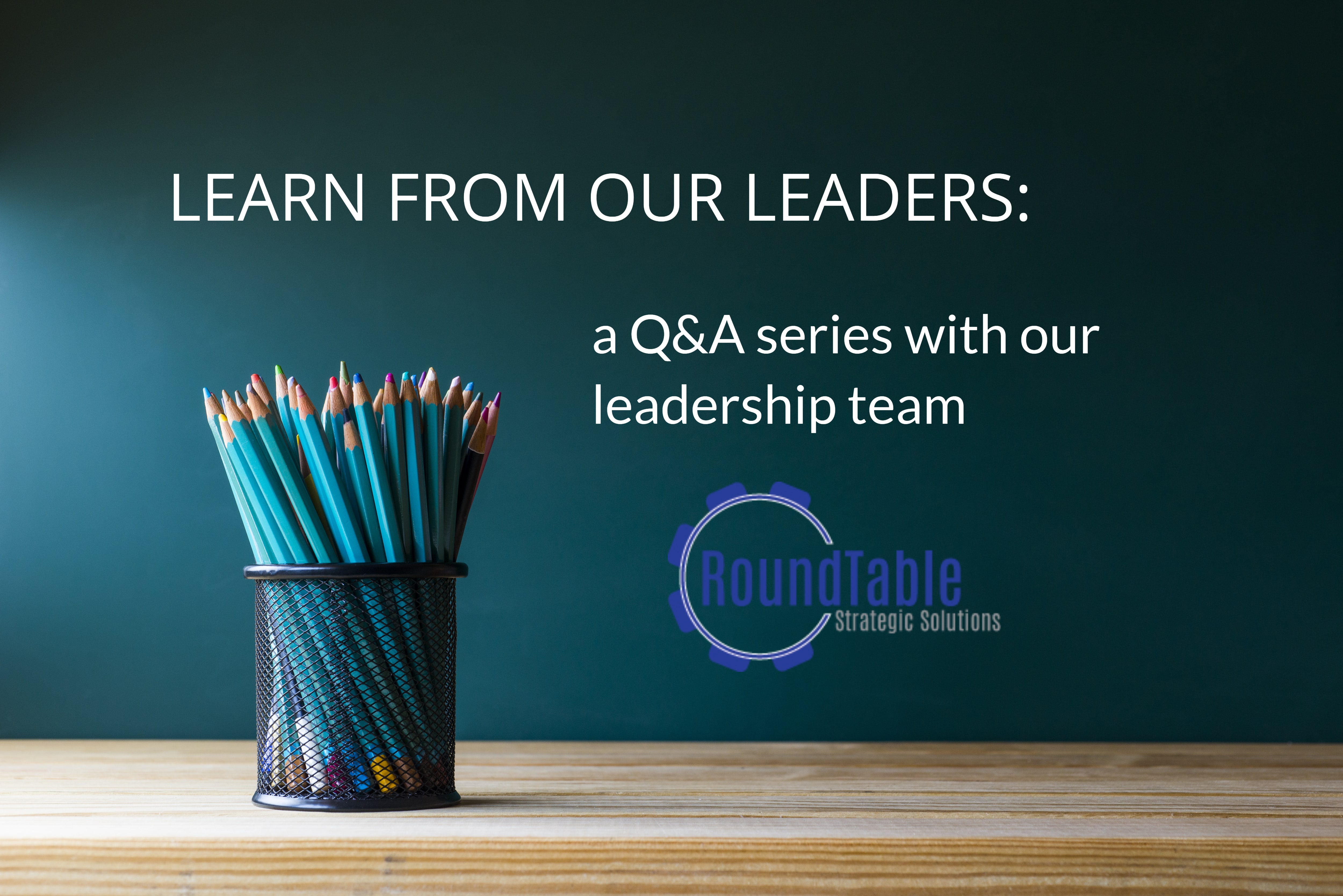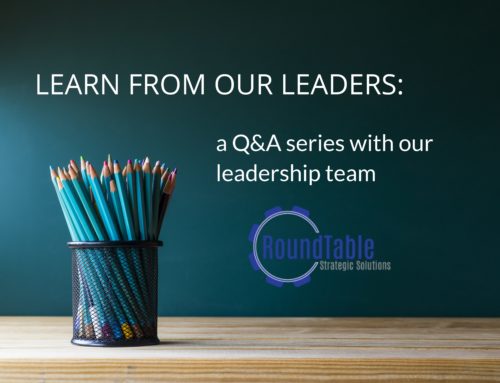Relationship Building & Management is Key to Talent Acquisition: 8 Qs with Lauren Rosenthal, Director of Recruitment and Delivery
“Recruiting the right person is something you enjoy, not just a job. It’s about getting to really know a person and build a relationship with them,” says Lauren Rosenthal, Director of Recruitment and Delivery for RoundTable Strategic Solutions. With more than 13 years of healthcare recruitment experience, Lauren is driven towards understanding and addressing the multi-faceted and evolving challenges facing healthcare delivery systems. She leverages in-depth knowledge of healthcare clinical, revenue cycle, and support operations and application tools to identify Consultants and Interim Leaders who are equipped to positively impact clients’ operational and financial performance and clinical outcomes.
According to a survey from the American Staffing Association, healthcare industry positions held eight of the top 10 spots of the most difficult occupations to fill. Recruiters in the healthcare IT and management industry are experiencing that challenge with the influx of job needs and the lack of aligning talent to fulfill the needs.
RoundTable has maintained an exceptional level of client satisfaction and 99% loyalty rate with our candidates and consultants. Lauren shares some of her thoughts on what makes the best recruitment process, and how open and value-driven communication is key to a recruiter/candidate’s relationship.
What are the general steps in the recruitment process?
In general terms, the steps to our recruitment process are a consistent cycle of:
- Identifying potential talented consultant and FTE candidates.
- Introducing ourselves and our brand to get them excited about what we’re doing and how their capabilities may be aligned with our opportunities.
- Getting to know the people in their network who they hold in high regard. It’s the ‘ripple in the pond’ metaphor where that initial candidate is a stone that is rippling out to others on both the candidate and client sides.
What is the most important component of creating a successful recruitment process?
Structuring your work approach so that you can continue to maintain those relationships, even when you don’t have the right fit for a candidate right now, or this year, or even three years from now. We have multiple consultants with whom we’ve engaged three and four years after we’ve had an initial conversation with them. It’s about maintaining that credibility and enough of a relationship that the candidate knows who you are, and they want to engage with you when the right opportunity presents itself.
The RoundTable approach is different, and that approach informs our process and what we can control. When we’re meeting a candidate, it’s our goal to understand their full capabilities, their current accomplishments and how they’ve achieved them—but then to understand what is driving them to look for their next opportunity, contract or FTE. There are varied drivers at play – the opportunity to make an impact, for example, the type of leadership structure that’s embedded in a client, exposure to new technology, to new resources, and an innovative approach. So it’s our goal in the recruitment process to really understand those factors that are driving candidates. When we’re looking at facilitating placement or engagement, we’re making sure that the appropriate ‘intangibles’ are aligned.
How do you find consultants, and how do you know that they are the right fit for the job?
If we have a preexisting network, our immediate focus is on our contacts in that network, and consultants for whom they have respect and a similar skill set. For net-new recruitment, where we don’t have a pre-existing related network, our initial approach is reaching out using professional networking sites or groups, like LinkedIn or the American College of Healthcare Executives. We reach out to those people who are most likely to have the skill set and the capabilities for which we’re looking. We then do a deep comparison of capabilities with client goals to ensure alignment.
Are there any current trends that impact the recruitment process?
From an outreach perspective, recruiting has traditionally been a transactional experience. In a pre-digital world, specific recruiters had specific opportunities and you had to go through that recruiter to get them. Particularly within healthcare IT, there has been a transformation regarding the players that are ‘in the game’. With many other recruiters available, my team needs to differentiate RoundTable from the white noise so that we elicit interest and response. And social networking, being able to connect with someone on Facebook or LinkedIn, makes it much easier for consultants to interact with their network, share information, likes and dislikes, provide feedback about clients and consulting firms – good or bad. As a result of these trends, maintaining that deeper dialogue has absolutely been huge for us.
Additionally, the industry approach to customization and optimization has changed. Projects that exist now are much more strategic in nature. It’s understanding the tools, resources, functionality, and limitations thereof coupled with what we’re trying to accomplish operationally, and how we can make improvements in operations that can support automation through digital technology resources. You need to have the right mix of all those skills to really be effective with what we’re trying to accomplish.
How much of the recruitment job is seeking consultants versus the consultants seeking positions that you’re trying to fill?
Most of our job right now is about seeking consultants to fill particular roles. We have specific needs that our clients have shared with us, and we are either going out and establishing new relationships, or going to the network that we have built and reassessing capabilities and alignment. The consultants with whom we work, and with whom we most actively want to engage, are in a position of relative power. They’re having their door knocked upon on a daily basis, therefore, the onus is on our recruitment team to differentiate ourselves and to present our opportunities in a way that will truly speak to a consultant who may only return one email or one call out of 20 different outreaches received.
However, in building new and maintaining pre-existing relationships, we’re also gaining traction from people who are interested in what we’re doing. Often, candidates do not directly align with our immediate opportunities; however, that doesn’t mean that they’re not a great fit for our organization and for our core competencies. We realize that it is critical to take the time to still have that thorough dialogue and fully understand where an opportunity may exist in the future, or where we can coordinate with the business development side of the house to identify an opportunity for that talented resource.
We need to ask ourselves, “Where can we synthesize an opportunity where we’re going to be able to highlight that candidate’s capabilities while serving a client’s needs?”
Are there parts of the recruiting process that you would like to improve or streamline?
On the project-based side, especially when recruiting for shorter-term engagements, it is challenging to align everything. Overall, we’re driving deeper conversation, but there are candidates who are used to that traditional transactional experience, and are hesitant to invest the extra time to build a deeper relationship. For those who are used to doing something a certain way, we have to really put ourselves out there to gain that additional level of trust.
I’d love to have the power to fix the ‘hurry up and wait’ scenarios, where we have the best candidate, and have a great potential placement but it is difficult to align calendars to schedule interviews, get tangible and timely feedback, or direction on next steps. It’s extremely difficult to maintain a balance of keeping that candidate excited while navigating delays and other red tape issues.
What are some of the biggest challenges that you see throughout the process?
In consulting, one challenge is that different clients have diverse tolerances for onsite versus remote presence; the logistics of travel definitely weigh on individuals differently. We have some consultants who have been out on the road for a long time and they become tired of the travel.
Another significant challenge we face is compensation. We’ve seen a shift in overall client tolerance for bill rates, which directly impacts what we can pay and still make it beneficial for all parties. Many times, our consultants want more than we can offer – it’s then critical to show the value in a particular project that’s not captured in an hourly rate. We would never want somebody to be below market value, but many times some degree of flexibility with rate is necessary to solidify a mutually beneficial scenario.
Many candidates are drawn in by the glamour of consulting, the higher dollars, and really cool, innovative work, but it’s not for everyone long term. We find ourselves at a crossroad, where there are some who have really broad consultative skill sets, but are ready for the stability of an FTE role. Another hurdle within that is overall appetite for relocation, or lack thereof – especially to rural areas that have limited access to resources and a lower cost of living.
What advice would you give to someone looking for a job in this market?
My biggest piece of advice would be to take advantage of any and all opportunities to diversify your skill set, no matter how niched you may be. Particularly in healthcare IT, things used to be relatively siloed. Things are so much more heavily integrated now. Having a global understanding of the way that different pieces of the puzzle fit together is absolutely critical. The people who are going to continue to do well and be engaged in these more strategic roles are going to have exposure to things that are ‘outside their wheelhouse.’ But it’s having that global picture and seeing different ways of doing things — being able to evaluate the impact of a particular approach or understanding limitations.






